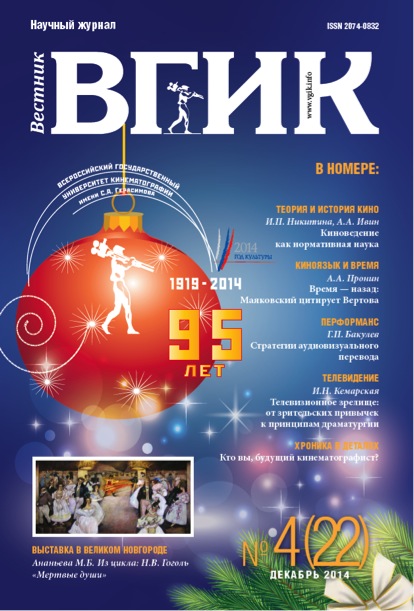Стратегии аудиовизуального перевода
- Авторы: Бакулев Г.П.1
-
Учреждения:
- ВГИК
- Выпуск: Том 6, № 4 (2014)
- Страницы: 48-60
- Раздел: ПЕРФОРМАНС | ИСКУССТВО ВОПЛОЩЕНИЯ
- URL: https://journals.eco-vector.com/2074-0832/article/view/14805
- DOI: https://doi.org/10.17816/VGIK6448-60
- ID: 14805
Цитировать
Полный текст
Аннотация
В статье рассматриваются две основные стратегии перевода в кино - дублирование и субтитрирование, которые различаются по степени вмешательства в оригинальный текст. С одной стороны, дублирование модифицирует исходный текст в большей степени, и таким образом делает его более понятным для аудитории. Тогда как субтитрирование, то есть представление диалога на целевом языке в форме синхронных субтитров, меняет исходный текст в наименьшей степени. Выбор стратегии перевода в основном зависит от социокультурных, но нередко и от политических факторов. В этой связи рассматриваются переводческие проблемы очуждения и освоения.
Об авторах
Геннадий Петрович Бакулев
ВГИК
Автор, ответственный за переписку.
Email: editor@vestnik-vgik.com
доктор филологических наук, профессор, кафедра русского и иностранного языков
Список литературы
- Козуляев А.В. Аудиовизуальный полисемантический перевод как особая форма переводческой деятельности. Обучение данному виду перевода // URL.: http://www.russian-translators.ru/about/editorial/audiovizualnyperevod / (дата обращения: 01.11.2014).
- Danan Martine (1991) "Dubbing as an Expression of Nationalism" Meta, XXXVI4, Munday, Jeremy (2001) Introducing Translation Studies. Theories and Applications. London and New York: Routledge.
- Diaz Cintas, Jorge and Anderman, Gunilla. Introduction // Audiovisual Translation Language Transfer on Screen / Edited by Jorge Diaz Cintas And Gunilla Anderman. Palgrave Macmillan, 2005.
- Hatim Basil and Ian Mason (1997) The Translator as Communicator. London: Routledge. Ascheid, Antje (1997) "Speaking Tongues: Voice Dubbing in the Cinema of Cultural Ventriloquism". In The Velvet Light Trap, no. 40.
- Venuti Lawrence (1995). The Translator's Invisibility. A History of Translation, London and New York: Routledge.
Дополнительные файлы








